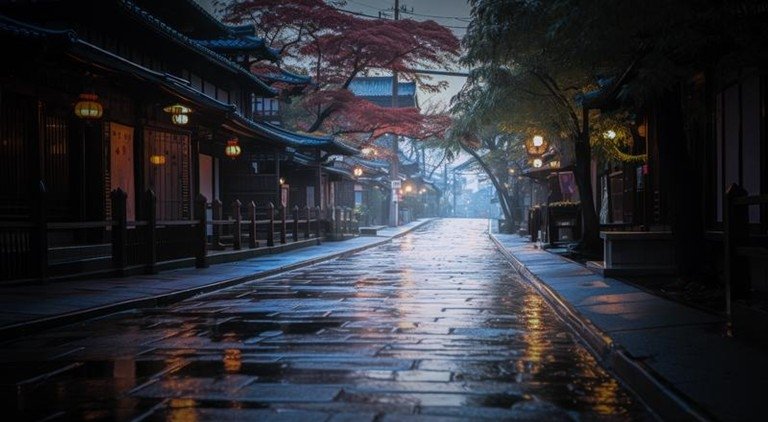26. Kenran (絢爛)
Definition:
A dazzling, resplendent beauty that captivates the eye.
Explanation:
Kenran embodies brilliance and lavishness, often used to describe scenes or objects that burst with vibrant, eye-catching colors and intricate details.
27. Kōsai (光彩)
Definition:
A radiant display of light and color.
Explanation:
Kōsai refers to the vibrant interplay of light that creates an almost magical spectrum of hues, evoking a sense of wonder and vitality in the observer.
28. Gen’ei (幻影)
Definition:
An illusory, ephemeral image that appears almost dreamlike.
Explanation:
Gen’ei captures the transient beauty of an image or scene that seems to exist on the edge of reality, hinting at mystery and the fleeting nature of life.
29. Seiryū (清流)
Definition:
A crystal-clear, gently flowing stream.
Explanation:
Seiryū symbolizes purity and natural elegance, with its clear waters reflecting the simplicity and continuous flow of nature.
30. Kōyō (紅葉)
Definition:
The vivid, fiery colors of autumn leaves.
Explanation:
Kōyō celebrates the dramatic transformation of foliage in the fall, evoking a sense of both warmth and the bittersweet nature of seasonal change.
31. Kiri (霧)
Definition:
A soft, enveloping mist or fog.
Explanation:
Kiri transforms familiar landscapes into scenes of quiet mystery, blurring the boundaries between the visible and the unknown in a serene, atmospheric display.
32. Shinkirō (蜃気楼)
Definition:
A mirage – a naturally occurring optical illusion.
Explanation:
Shinkirō captures the surreal beauty of an image that appears real yet is intangible, reminding us of nature’s capacity to create fleeting, almost magical phenomena.
33. Sazanami (漣)
Definition:
Gentle ripples on the surface of water.
Explanation:
Sazanami evokes the calming rhythm of small waves, suggesting the quiet and continuous movement found in natural settings.
34. Kaori (香)
Definition:
A delicate, lingering fragrance.
Explanation:
Kaori represents the subtle aroma that can evoke memories or emotions, highlighting the beauty found not just in what is seen, but also in what is sensed.
35. Shizuku (雫)
Definition:
A tiny droplet of water that sparkles in the light.
Explanation:
Shizuku emphasizes the exquisite beauty in small details of nature, symbolizing purity and the transient perfection found in each moment.
36. Uruwashii (麗)
Definition:
A refined and graceful beauty.
Explanation:
Uruwashii conveys an elegant charm that is both timeless and captivating, often used to describe aesthetics that are both sophisticated and naturally alluring.
37. Saki (咲)
Definition:
The act or moment of blooming.
Explanation:
Saki captures the vibrant energy and ephemeral beauty of a flower in bloom, symbolizing life, renewal, and the fleeting nature of beauty.
38. Mange tsu (満月)
Definition:
The luminous glow of a full moon.
Explanation:
Mange tsu evokes the complete and serene illumination of the night sky, inspiring awe with its gentle and all-encompassing light.
39. Kagerō (陽炎)
Definition:
A shimmering heat haze that distorts the air.
Explanation:
Kagerō describes the mirage-like effect often seen on hot days, merging reality with illusion and highlighting the transient nature of perception.
40. Aozora (青空)
Definition:
A vast, clear blue sky.
Explanation:
Aozora represents freedom, openness, and the infinite possibilities of a cloudless day, evoking a sense of optimism and expansiveness.
41. Yuyami (夕闇)
Definition:
The deep, enveloping twilight of dusk.
Explanation:
Yuyami captures the quiet, introspective mood of the evening when day softly transitions into night, inviting contemplation and calm.
42. Madoromi (微睡)
Definition:
A light, drowsy state between wakefulness and sleep.
Explanation:
Madoromi suggests a gentle, almost meditative slumber, evoking the peaceful and dreamy quality of moments when the world seems to slow down.
43. Ryūsei (流星)
Definition:
A shooting star that streaks across the night sky.
Explanation:
Ryūsei symbolizes a fleeting, magical moment of brilliance—a brief flash of beauty that leaves a lasting impression.
44. Sakura-fubuki (桜吹雪)
Definition:
A flurry of falling cherry blossom petals.
Explanation:
Sakura-fubuki conjures the image of delicate petals swirling in the wind, epitomizing the transient yet breathtaking beauty of springtime in Japan.
45. Yukidoke (雪解け)
Definition:
The gentle thawing of snow as it melts.
Explanation:
Yukidoke signifies renewal and the transient nature of winter’s grip, marking the delicate transition from the cold of winter to the promise of spring.
46. Seihitsu (静謐)
Definition:
A state of profound tranquility and serenity.
Explanation:
Seihitsu encapsulates the calm that pervades moments of deep quiet, inviting reflection and the appreciation of peaceful solitude.
47. Uruoi (潤い)
Definition:
A rich, vibrant freshness or vitality.
Explanation:
Uruoi reflects the nourishing, life-giving quality found in nature and in moments of emotional fulfillment, suggesting both physical and spiritual rejuvenation.
48. Akatsuki (暁)
Definition:
The first light of dawn, heralding a new day.
Explanation:
Akatsuki embodies hope and renewal as the darkness recedes, inviting us to embrace new beginnings with optimism and grace.
49. Kinu (絹)
Definition:
Silk – known for its smooth, lustrous texture.
Explanation:
Kinu symbolizes luxury, elegance, and the refined beauty of something that is both delicate and enduring in its allure.
50. Kunpū (薫風)
Definition:
A gentle, fragrant breeze that carries the scent of blossoms.
Explanation:
Kunpū evokes the refreshing and revitalizing qualities of a soft wind, filled with subtle aromas that soothe the senses and evoke the beauty of nature.


Comments